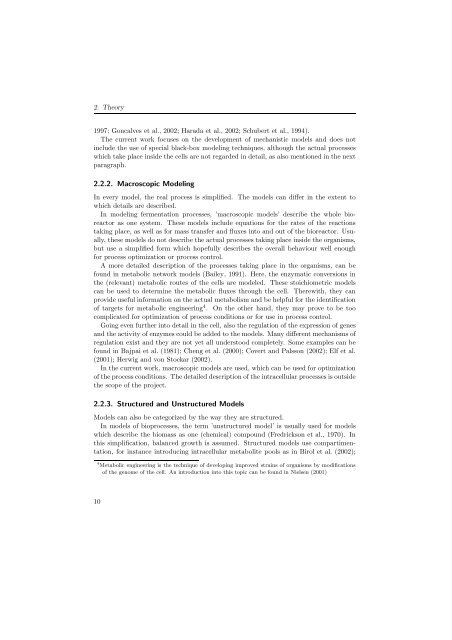Corynebacterium glutamicum - JUWEL - Forschungszentrum Jülich
Corynebacterium glutamicum - JUWEL - Forschungszentrum Jülich
Corynebacterium glutamicum - JUWEL - Forschungszentrum Jülich
Create successful ePaper yourself
Turn your PDF publications into a flip-book with our unique Google optimized e-Paper software.
2. Theory<br />
1997; Goncalves et al., 2002; Harada et al., 2002; Schubert et al., 1994).<br />
The current work focuses on the development of mechanistic models and does not<br />
include the use of special black-box modeling techniques, although the actual processes<br />
which take place inside the cells are not regarded in detail, as also mentioned in the next<br />
paragraph.<br />
2.2.2. Macroscopic Modeling<br />
In every model, the real process is simplified. The models can differ in the extent to<br />
which details are described.<br />
In modeling fermentation processes, ’macroscopic models’ describe the whole bioreactor<br />
as one system. These models include equations for the rates of the reactions<br />
taking place, as well as for mass transfer and fluxes into and out of the bioreactor. Usually,<br />
these models do not describe the actual processes taking place inside the organisms,<br />
but use a simplified form which hopefully describes the overall behaviour well enough<br />
for process optimization or process control.<br />
A more detailed description of the processes taking place in the organisms, can be<br />
found in metabolic network models (Bailey, 1991). Here, the enzymatic conversions in<br />
the (relevant) metabolic routes of the cells are modeled. These stoichiometric models<br />
can be used to determine the metabolic fluxes through the cell. Therewith, they can<br />
provide useful information on the actual metabolism and be helpful for the identification<br />
of targets for metabolic engineering 4 . On the other hand, they may prove to be too<br />
complicated for optimization of process conditions or for use in process control.<br />
Going even further into detail in the cell, also the regulation of the expression of genes<br />
and the activity of enzymes could be added to the models. Many different mechanisms of<br />
regulation exist and they are not yet all understood completely. Some examples can be<br />
found in Bajpai et al. (1981); Cheng et al. (2000); Covert and Palsson (2002); Elf et al.<br />
(2001); Herwig and von Stockar (2002).<br />
In the current work, macroscopic models are used, which can be used for optimization<br />
of the process conditions. The detailed description of the intracellular processes is outside<br />
the scope of the project.<br />
2.2.3. Structured and Unstructured Models<br />
Models can also be categorized by the way they are structured.<br />
In models of bioprocesses, the term ’unstructured model’ is usually used for models<br />
which describe the biomass as one (chemical) compound (Fredrickson et al., 1970). In<br />
this simplification, balanced growth is assumed. Structured models use compartimentation,<br />
for instance introducing intracellular metabolite pools as in Birol et al. (2002);<br />
4 Metabolic engineering is the technique of developing improved strains of organisms by modifications<br />
of the genome of the cell. An introduction into this topic can be found in Nielsen (2001)<br />
10

















